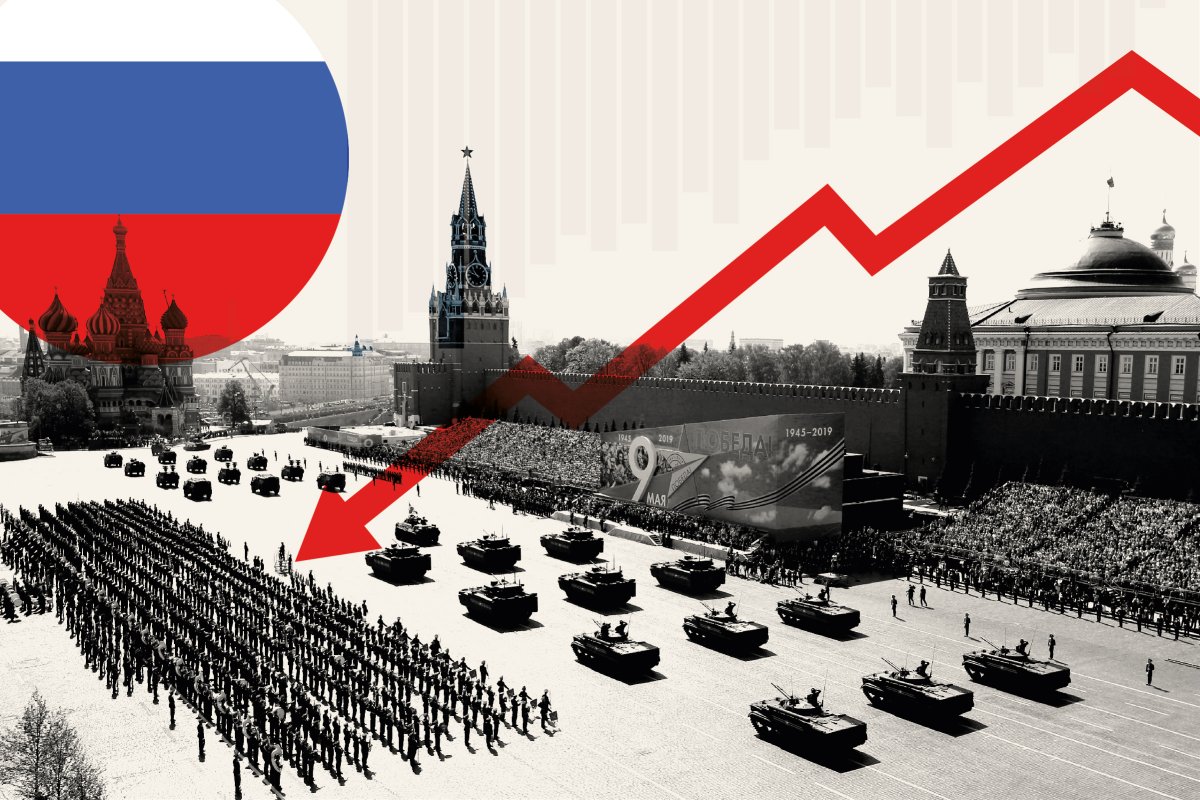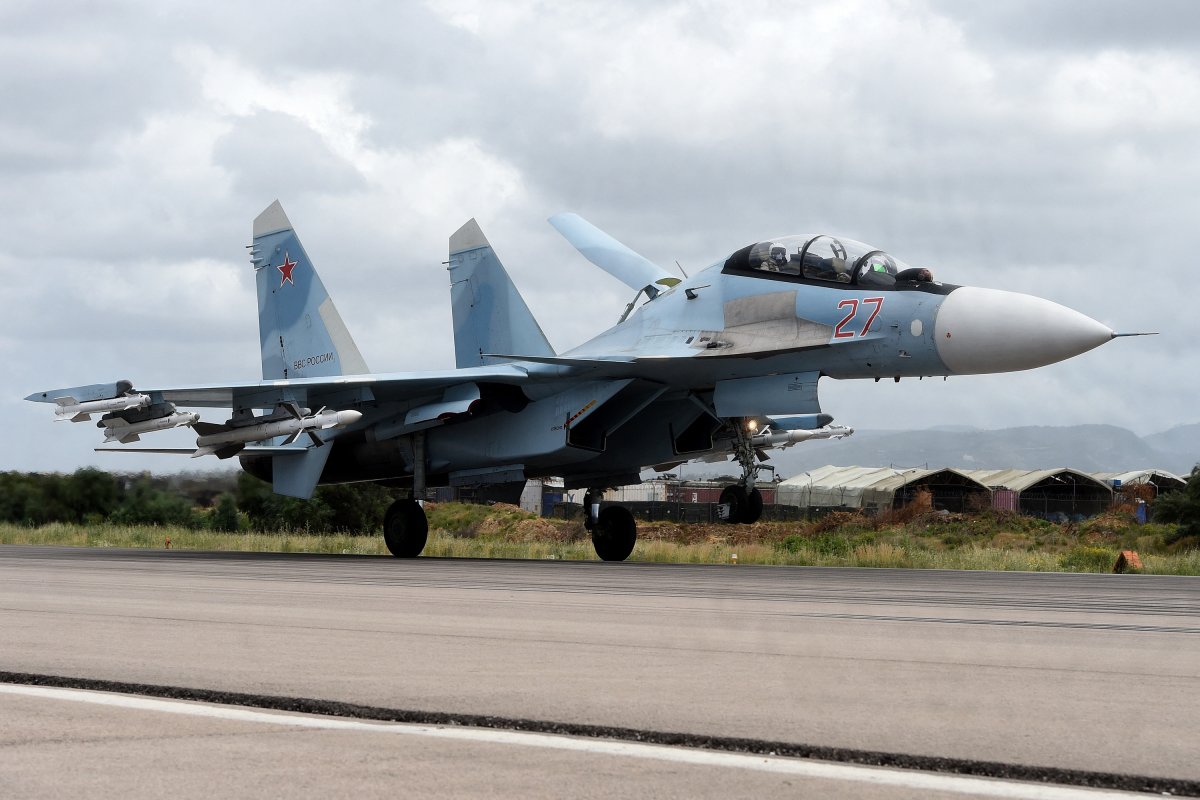Russia's arms export industry—historically the second most lucrative in the world after the United States—appears to be collapsing under the weight of technological shifts, international political isolation, and its disastrous war in Ukraine, according to new figures released by the world's leading weapons industry watchdog.
Data published by the Stockholm International Peace Research Institute (SIPRI) on Monday show that Russia's military exports fell by 31 percent over the past five years when compared with the five years previous, threatening Moscow's position as the world's second most influential weapons dealer.
Russia's share of global arms exports fell from 22 to 16 percent between 2013-2017 and 2018-2022, leaving it far behind the U.S. which accounts for 40 percent of military exports, and only slightly ahead of France, which was the source of 11 percent of arms exports over the past five years.
SIPRI's latest data confirms Newsweek reporting from last year indicating a bleak trajectory bleak for Russian military exporters. "It's really substantial, but it's not really surprising," Siemon Wezeman, a senior SIPRI researcher, told Newsweek. "And it's not just because of what's happening in Ukraine in 2022; it's something that you could see coming."

The West has been working to isolate Russia since its invasion and annexation of Crimea—and its fomentation of unrest in Ukraine's Donbas region—since 2014. The effort has been supercharged since Russian troops again rolled into Ukrainian territory in February 2022. Led by Washington, D.C., Moscow's adversaries are chipping away at the Kremlin's customer base.
Meanwhile, the staggeringly high rates of Russian casualties and equipment losses in Ukraine are putting defense producers under pressure, as are the less-than-stellar performances of key Russian weapons platforms that appear unable to counter the most advanced NATO arms used by Ukrainian troops.
Denis Manturov, Russia's deputy prime minister of industry and trade, told Interfax last month that a "significant" portion of weapons being produced in the country are being directed to Ukrainian battlefields. "Their provision is our absolute priority, but even in these conditions we continue to work with our partners from friendly countries and fulfill our obligations," he said.
Newsweek reached out to the Russian Industry and Trade Ministry by email for comment on SIPRI's report.
An Isolated Seller
"There are different issues that Russia has to struggle with," Wezeman said. "One, of course, is the pressure from the U.S. and others—already ongoing since 2014—on potential customers and existing customers of Russia, to stop and not to buy Russian, and at the same time offering them alternative technology and alternative weapons.
"They did it very strongly with India, but they also do it with others. They've done it with Indonesia, and that led Indonesia to cancel an order of Russian combat aircraft. They've done it with Egypt, where it's not said so loud, but Egypt had an order for combat aircraft from Russia and that has gone. It's pretty obvious, I would say, that the U.S. pressured them."
The problem pre-dated the full-scale invasion of Ukraine, though has been exacerbated by President Vladimir Putin's revanchist gambit.
"They would still have those issues," Wezeman said. "The invasion, of course, adds to that because it's even more pressure from the U.S. and other states: 'Don't buy from Russia. You're either with us or you're against us. If you buy from Russia, you look like you're against us. And if you're with us, maybe we are willing to supply all kinds of wonderful technology.'"
"Maybe two years ago that would have been a bit iffy, but nowadays they are willing to do it," he added.
The unprecedented Western sanctions campaign against Moscow is biting. Russia's economy did not shrink to the degree expected last year, but the Kremlin's budget deficit is ballooning as its fossil fuel export profits dwindle. More than 1,000 foreign companies have fled Russia, and export controls are making it more and more difficult for indigenous manufacturers to get advanced components needed for high-tech goods and weapons.
One source with knowledge of Russia's military industries—who requested anonymity for fear of retaliation—told Newsweek: "First, export contracts have now been pushed back into the farthest corner, as the needs of the military are the top priority. Second, I suspect there will be significant delays in delivering on even the existing agreements, due to the combination of foreign-made parts supplies getting cut off and the struggle to ramp up domestic production.
"Plus, the whole world is getting a demonstration of the 'quality' of Russian arms and tech in real-time, which has been uninspiring, to put it mildly," they said. "Case in point is that Russia has resorted to buying combat drones from Iran, a country that has been under U.S. sanctions for years. I think we are seeing the early stages of a process whereby Russia drops out of the list of top global weapons exporters. It will continue to trade with the likes of the Taliban and a handful of allied nations, perhaps through some barter deals, but that's about it."
The source also noted the difference between the levels of quality control for military-industrial sector products supplied to the Russian military compared to those earmarked for export. The latter undergoes minimal checks, with only basic "commercial level" quality control needed to certify the goods for export.
"So, the result is that often companies working with foreign buyers will hoover up anything and everything on the market, including second-hand goods, rusty or malfunctioning parts, even blatant counterfeit. So that obviously impacts the quality of such exports," they said.

Moscow is casting around for suppliers as its forces struggle to make ground in Ukraine. Iran, North Korea and Belarus have been key sources of equipment and ammunition over the past year, while nations including Turkey, the United Arab Emirates and the central Asian states have emerged as potential sanctions-busting conduits for dual-use technologies. But even these channels are narrowing under pressure from the Western allies.
China has so far refrained from direct military support for Russia's invasion, though according to U.S. officials has not yet decided on whether to withhold weapons entirely. Chinese state-owned companies are reportedly providing dual-use technology to Russia, prompting calls to extend Western sanctions to Beijing, too.
"The Chinese have to really think, 'What's in it for me if I help the Russians? And what's in it for me if I don't?'" Wezeman said.
Russia Left Behind
Russia is facing a reputational quandary exacerbated by its military's sub-par performance in Ukraine. Moscow's limited military successes have come from massed, plodding offensives supported by withering artillery fire.
The Kremlin's early failure to debilitate the Ukrainian government with a costly, ill-prepared thunder run on Kyiv showed the limits of Moscow's expensive decade-long modernization drive, and the stubborn rot of corruption and Soviet-era organization.
Putin and his top allies have tried to present Russia as a technologically-advanced power capable of competing with its rivals in North America and Europe, but the actual goods it produces—and its inability or unwillingness to field its supposedly most advanced weapons, like the T-14 Armata tank and the Su-57 fighter jet—tell a different story.
"The biggest states are looking for more advanced weapons, and cooperation and technology transfer," Wezeman said. "They're not so very confident of Russian technology."
"The development of Russian technology in some fields is fine, also in some weapon fields, but across the board, it isn't that great," Wezeman added. "And of course, that's based on the Russian economy, which is weak and it's not really very advanced in technology. It means a lot of question marks as to whether the Russians will be able to deliver 10, 20, 30 years from now something which is still a valid, capable weapon."
The importance of such concerns will vary depending on the customer. Though Moscow's arms exports to sub-Saharan Africa fell by 23 percent in the period detailed, Russia still overtook China as the largest arms supplier to the region.
"If you're an African country it doesn't really matter so much. Simple stuff is fine and that works," Wezeman said. "But if you're India, you want technology transfers, and you just don't believe it anymore."

Indeed, SIPRI's data paint a sobering picture of Russia's declining allure among its most important customers, with arms exports decreasing to eight of its 10 biggest recipients between 2013–2017 and 2018–2022.
India—Russia's largest market—saw a fall of 37 percent. Though exports increased to China by 39 percent and Egypt by 44 percent over the time period, the long-term picture is not encouraging.
"Russia made no deliveries to Egypt in 2021–22 and the volume of deliveries to China in 2020–22 was at a much lower level than in 2018–19," SIPRI's report read. "It is likely that order volumes from these two states will reduce in the coming years."
The Chinese market, Wezeman said, is "completely disappearing." He explained: "The Chinese are basically finishing the technology development of the last things they need from Russia a couple of years now; there's nothing they need anymore."
Russia's 'Bleak' Future
Moscow's war on Ukraine has only deepened many of Russia's long-standing economic, political, and social problems. Rather than cow the West, the Kremlin's latest bout of aggression may have touched off an epochal European re-evaluation of military readiness, perhaps sounding the end of the low-spending post-Cold War era that has so frustrated the American national security establishment.
SIPRI found that European NATO states increased their arms imports by 65 percent over the five years in question, seeking "to strengthen their arsenals in response to a perceived heightened threat from Russia."
Europe's high-tech military-industrial firms are in a good position to benefit from the demands of modern warfare, even if they cannot yet reach the scale desired.
"We looked also at what is known to be on order in major weapons and that looks very bleak," Wezeman said of Russia's future outlook. "Russia has less combat aircraft on order than, for example, France, or even Italy."
"If you look at five years ago, Russia had far more than 100 combat aircraft on order every year...now, there are less than 100 spread over the coming years, and some of those may not even happen because the pressure is on some of the buyers."

Last summer, for example, new Philippines President Ferdinand Marcos Jr. canceled a deal for 16 Russian-made Mi-17 helicopters under pressure from the U.S. And Egypt, Algeria, and Indonesia have all ducked out of potential purchases of Russia's Su-35 bomber aircraft.
"The low volume of pending deliveries of major arms from Russia indicates that its arms exports are likely to continue to drop in the coming years," SIPRI's report said.
"Combat aircraft and combat helicopters have been among Russia's main arms exports since 1992. It delivered a total of 328 of these in 2018–22, which accounted for 40 percent of Russian arms exports in the period. However, by the end of 2022, it had pending deliveries for only 84 combat aircraft and combat helicopters."
Putin's dream of a "fortress Russia" was built on a foundation of fearsome military strength. The Kremlin's costly humiliation in Ukraine and choked economy hint at a very different future for Putin's new Russian empire.
"A couple of years from now, Russia may well be number three, maybe even number four" in global military exports, Wezeman said. "That's really very striking."
Uncommon Knowledge
Newsweek is committed to challenging conventional wisdom and finding connections in the search for common ground.
Newsweek is committed to challenging conventional wisdom and finding connections in the search for common ground.
About the writer
David Brennan is Newsweek's Diplomatic Correspondent covering world politics and conflicts from London with a focus on NATO, the European ... Read more
To read how Newsweek uses AI as a newsroom tool, Click here.








